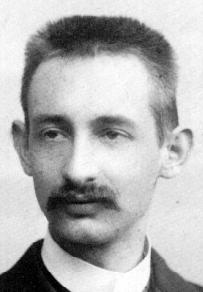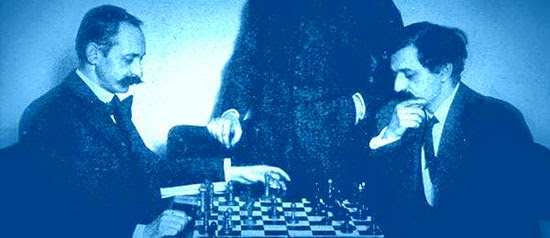After his successful title defence against Tarrasch in 1908, Lasker could not rest on his laurels. The list of challengers waiting for their turn was growing every day.
 On December 2, 1908, Austrian master Karl Schlechter sent an official challenge to Lasker. Schlechter was one of the leading players in the late 1890s and early 1900s. He was well known for his solidity. His style of play was strategic and positional and most importantly – risk averse. His nickname was „the king of the draw.“; in the 1900s, he set a record of only two losses in 100 successive tournament games, a record which „will stand unshaken for many a year to come.“ (Source: Chessgames – Carl Schlechter)
On December 2, 1908, Austrian master Karl Schlechter sent an official challenge to Lasker. Schlechter was one of the leading players in the late 1890s and early 1900s. He was well known for his solidity. His style of play was strategic and positional and most importantly – risk averse. His nickname was „the king of the draw.“; in the 1900s, he set a record of only two losses in 100 successive tournament games, a record which „will stand unshaken for many a year to come.“ (Source: Chessgames – Carl Schlechter)
Despite his reputation, he managed to win a number of important tournaments and gained every right to challenge a Lasker to a match. Lasker accepted his challenge. Initially, the players announced that the match would last 30 games and that a score of +2 is required for a match win. Lasker initially tried to obtain 1000 DM per game (which was a huge amount of money at the time). However, due to the lack of funds, the number of games was reduced from 30 to 10 instead. (Source: Chesspedia – Lasker – Schlechter match).
The match took place in Vienna and Berlin and started on January 7, 1910. It turned out to be the most dramatic World Championship match played up to that point. And one of the most dramatic World Championship matches in the overall history.
The battle was extremely hard fought and Schlechter proved his nickname was well-deserved. By employing Open Ruy Lopez with the Black pieces, and diffusing Lasker’s trademark Steinitz Defence with the White pieces, he had no problems in holding four draws in the opening four games of the match.
Then, in the fifth game, Lasker set his king on an audacious journey on the queenside and managed to outplay his opponent. He was close to reaping the rewards of his instructive play, but Schlechter resisted persistently, and with a pawn sacrifice on the queenside managed to open Lasker’s king. In the fighting position, Lasker first overstepped the mark and lost his chances to win, and then with another mistake also lost his chances to draw the game.
Thus, before the Berlin part of the match, Lasker found himself in precarious position – minus one with five games to go and tough-to-beat opponent. Despite playing more aggressively and switching to the c5 Sicilian, the next four games also finished in a draw. Therefore, before the last game, Lasker was in desperate situation – having to win the last game of the World Chess Championship.
Lasker opened the final game with 1 d4. Schlechter responded with a nervy and risky set-up and Lasker quickly got strategically won position. However, a nervy push of the g-pawn allowed a lot of counterplay to his opponent. In the double-edged position, it seemed that Schlechter’s chances were higher. However, on move 35 he embarked on a faulty combination and lost an exchange as a result. Soon afterward, he committed another blundered and allowed the exchange of the queens. After the titanic battle that lasted 71 moves, Schlechter resigned.
Therefore, with the match result standing at 5-5, Lasker managed to retain his crown.
Still, many spectators were puzzled with Schlechter’s manner of play; it was unclear why he tried playing so hard to win. Since the official match conditions are not known to this day, a lot of theories have tried to explain events behind the scenes. It was mostly speculated the match conditions stated that a player should win the match by a 2 point margin (as was originally proposed for a 30 game match). Also, there are those who assume Schlechter, an honorable gentleman, regarded his win in the 5th game „lucky“, and wanted to win one game deservingly. However, none of these speculations were proven by any means.
This footnote from the chessgames article on Lasker-Schlechter match pretty much sums all the possible reasons for Schlechter’s eagerness to win:
Since the final conditions for the match have never been published, there are rumors that Schlechter had to win the match by a score of +2 to become world champion. A +2 clause existed in the conditions issued by both players on 3 December 1908. In addition, when communicating his terms to his challenger Jose Raul Capablanca in The Evening Post of 22 November 1911, the second clause determined that if the match ended with the scores 1:0, 2:1 or 3:2, the match was to be declared drawn. After Capablanca’s protest, Lasker explained that a difference of one point was very slight and that the rule was directed against the hopes of nursing a one point lead to match victory by drawing the rest of the games. A score of 4:3 with 23 draws would establish proof of severe fighting and suffice for a match win.
In both cases, with explicit +2 clauses demanded, the matches could last up to 30 games. The present match consisted of 10 games only, which makes a comparison doubtful. We know of no contemporaneous source claiming that there was a +2 clause in effect in the actual world championship match, except for one: Richard Forster quoted a report in the Basler Nachrichten of 20 February 1910 in C.N. 4144 by Walter Preiswerk, who was in Leipzig at that time. Preiswerk claims that Schlechter, instead of becoming world champion by drawing the tenth game, would have had to play a rematch regardless of the financing in that case. Both chessplayers, also excellent businessmen, didn’t like this prospect. Winter notes that it is difficult to know quite what to make of this commentary.
In C.N.s 7109 and 8222, Winter shows examples of how the alleged +2 clause is usually introduced in books, by referring to the conditions without mentioning the sources and although the final conditions have so far not been found published anywhere (Winter). An example of this type of claim is given by Garry Kasparov, who simply states that However, to all appearances, one of the points stated that to win the title the challenger had to gain an advantage of two points, and that if Schlechter were to win by one point (5½-4½) the match would be declared… drawn. (Garry Kasparov, On My Great Predecessors Part I, 2003, Everyman, p.173) and presenting the speculation as an established fact later (Kasparov, p.177).
Winter presents a list of items on this controversial question in C.N. 7109 for everyone who is further interested in the topic. When researching the matter, we found no indication that such a clause existed. Neither Schlechter, nor Lasker explain the challenger’s enterprising play in game 10 by a +2 clause. The annotators of game 10 also don’t mention it.
Still, as long as the final conditions are not known, this matter remains open for debate.

